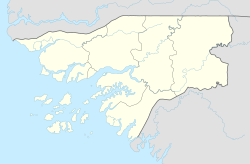Madina do Boé
| Madina do Boé Boé |
||
|---|---|---|
|
|
||
| Coordinates | 11 ° 45 ′ N , 14 ° 19 ′ W | |
| Basic data | ||
| Country | Guinea-Bissau | |
| Leste | ||
| region | Gabu | |
| ISO 3166-2 | GW-GA | |
| height | 76 m | |
| surface | 3,287.8 km² | |
| Residents | 10,878 | |
| density | 3.3 Ew. / km² | |
|
Location of the Boé sector (pink, at the bottom) in the Gabú region
|
||
Madina do Boé (usually Boé for short ; more rarely Madina Boé , Medina de Boé ) is a town in the southeastern region of Gabú in Guinea-Bissau with 73 inhabitants (as of 2009).
Boé is also an administrative sector with an area of 3287.8 km² and 10,878 inhabitants (as of 2007).
Boé was briefly the capital of the country in 1973/1974.
Geography and climate
The district (sector) Madina do Boé is located in the Gabú region in eastern Guinea-Bissau, not far from the border with neighboring Guinea .
The landscape, which is unusually dry for Guinea-Bissau, is characterized by savannah . In particular, different rivers allow a partially lush flora, to mention in particular the area of Complexo Dulombi, Boé e Tchetche , which today belongs to the nature reserves of Guinea-Bissau and from which two national parks will emerge.
The average annual temperature in the sector is about 25 ° C . During the day the temperatures are usually between 30 and 33 ° C, at night between 18 and 23 ° C.
The village is located 76 m above sea level. Further south, the land continues to rise to the Colinas do Boé , the highest point in Guinea-Bissau. Behind the border in Guinea the country rises further to the Fouta Djallon mountain country.
Madina do Boé is about 150 km from the Guinea-Bissau capital of Bissau . Places in the vicinity are z. B. Sare Ussamane (approx. 3 km away), Sebere Dandun (approx. 4 km away) and Bantanja (approx. 4 km away).
history
In the course of the Portuguese colonial war , which lasted from 1963 to 1974 in Guinea-Bissau and was particularly intense here, the Portuguese army withdrew from this area in early February 1969 before the attacks of the PAIGC independence movement . 47 Portuguese soldiers died when they crossed the Rio Corubal near Ché Ché (Cheche). The accident remained unforgotten and has remained the subject of documentaries in Portugal to this day.
In July 1973 the PAIGC met in Fulamor (the eastern part of Madina do Boé). On September 24, 1973, Guinea-Bissau's independence from Portugal was unilaterally declared in Madina do Boé . From then on it was the capital of Guinea-Bissau until its internationally recognized independence on September 10, 1974. It was replaced by today's capital Bissau .
population
There are 73 people in the village of Madina do Boé (as of 2009) and around 722 people in the surrounding area (radius approx. 7 km). There are 10,878 people living in the entire Madina do Boé sector.
They mainly belong to the Fulbe ethnic group ( Portuguese : Fula ). The majority profess Islam and live in small villages.
structure
The Madina de Boé sector comprises a total of 83 localities, mostly rural villages ( Tabancas ). The most important towns in the sector include (stand 2209):
- Beli (870 inhabitants)
- Bouloubã (Cumbia) (274 inhabitants)
- Capebande (317 inhabitants)
- Dandum (486 inhabitants)
- Guiledje (522 inhabitants in three villages)
- Madina do Boé (73 inhabitants)
- Santa Saré (384 inhabitants)
- Tchetché (also Ché Ché or Cheche, 299 inhabitants)
- Vendu Leide (353 inhabitants)
Economy and Transport
The region is considered the poorest part of the country. Agriculture and especially animal husbandry (cattle, goats), plus fishing in the rivers essentially form the self-sufficiency economy in the sector.
After the discovery of bauxite deposits in the Boé sector, the government of Guinea-Bissau signed a contract with the semi-state Angolan mining company Angola Bauxite in 2007 to create a mine with an annual production capacity of 3 million tons. However, due to internal political crises in Guinea-Bissau and renegotiations, the treaty has not yet been implemented. The new government of Guinea-Bissau feels that the original contract is unfair, as only 10% of the revenue will go to Guinea-Bissau and 90% to the Angolan company. The construction of the loading port in Buba , via which the bauxite was to be shipped, has not yet been completed as part of the contract.
Boé is poorly served by roads. The most important road to the regional capital Gabú, 33 km away, is a dirt road, which is usually not continuously passable in the rainy season between May and October.
The sector also does not have an airfield.
sons and daughters of the town
- Mário Manuel da Silva (* 1961), Portuguese Olympic athlete
Web links
Individual evidence
- ↑ a b c d Inhabitants by region, sector and town by gender, 2009 census (p. 93), PDF access from the National Statistics Office INE of January 26, 2018
- ↑ Annual Statistical Report Guinea-Bissau 2015 (p. 10), PDF available from the National Statistics Office INE on January 26, 2018
- ↑ a b Joana Petrolho, Marta Rosa: À Descoberta da Guiné-Bissau. , Afectos com Letras / EU, Pombal 2015, ISBN 978-989-20-6252-5 , p. 81
- ↑ Hit list for Madina de Boé , TV recordings on YouTube , accessed on January 26, 2018
- ^ Bissau government to review Angola Bauxite deal, calls it unfair , article dated August 23, 2012 by Reuters news agency , accessed on January 26, 2018
- ↑ Joana Petrolho, Marta Rosa: À Descoberta da Guiné-Bissau. , Afectos com Letras / EU, Pombal 2015, ISBN 978-989-20-6252-5 , p. 84

